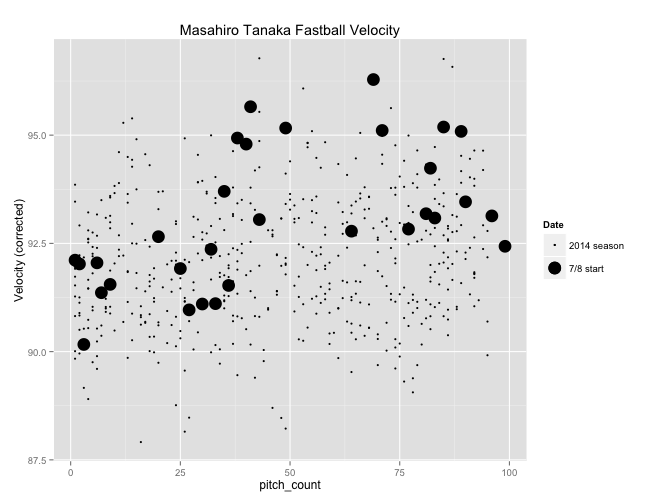“I want to apologize to the Yankees organization, my teammates and our fans for not being able to help during this time.” —Masahiro Tanaka, 7/11/14
Okay, so I’m a little late to arrive on the scene. One week ago, the New York Yankees announced that starting pitcher Masahiro Tanaka has a partially torn Ulnar Collateral Ligament in his throwing elbow. If the righty isn’t able to rehab the injury, he will soon go under the knife.
Every time the league loses someone as outstanding as Tanaka, people generally want answers. What caused this injury? How could it have been prevented? Should the Yankees quarantine the rest of their starting pitchers?
I’ve said this before, but any PITCHf/x model designed to prevent torn elbow ligaments doesn’t actually prevent torn elbow ligaments—instead, the goal is to catch these types of injuries before they get significantly worse. Most pitchers tend to remain silent about elbow discomfort until things get out of hand. We wish Jose Fernandez wouldn’t have put his need to “not let his team down” above his desire to remain healthy. At this point, I’m sure he wishes that too.
Masahiro Tanaka makes a great candidate for an elbow injury concealer. He appears to care so deeply about contributing to his team’s success that he issued what might be the first injury apology statement Major League Baseball has ever seen. The quote heading this article is taken from that statement, and I’m sure it gave more than a few New Yorkers a new favorite player to cheer for. I mean, how long did it take Ryan Braun to apologize for lying to his friends and his fans?
With Tanaka, most seem to assume that the predictability of his injury can be found in his on-field performance. After a nine-inning, eight-strikeout performance against Boston on June 28th, Tanaka posted his two worst outings of the season. On July 3rd, Tanaka wasn’t terrible, but he wasn’t great either; he allowed four earned runs over seven innings while striking out only three Minnesota Twins. His most recent start was a 99-pitch effort in which he allowed 10 hits and five whole earned runs. I know, I know—five earned runs? He must have had a partially torn Ulnar Collateral Ligament.
Let’s start with Tanaka’s second-to-last outing. As I noted in my Five-Day Pitcher Injury Zone article, there isn’t much in the PITCHf/x data to suggest that early warning signs can be detected one start before an elbow injury exit. Though there isn’t much data to back it up, an argument can be made for an upward shift in release point as a signal of elbow discomfort. An over-the-top delivery puts less strain on the UCL ligament than a three-quarters release angle, and more than 70 percent of elbow injuries I’ve looked at have been preceded by at least a minor upward release point shift in the second-to-last start.
Tanaka isn’t one of those to exhibit an upward shift in his fastball release point, though. His second-to-last start looked much like any of his previous starts. Sure, the result wasn’t what we’re used to seeing from him, but PITCHf/x doesn’t suggest that Tanaka’s July 3rd start was anything out of the ordinary.
The Last Start
It is quite possible that Tanaka was feeling pain in his elbow, but not enough to make any mechanical changes until his final start. As a pitcher approaches an injury exit, the warning signs obviously become a little clearer. Just before the exit, we tend to see significant drops in velocity and (sometimes) dramatic fluctuations in release point. Tanaka, however, doesn’t appear to fall into either category. Let’s look at velocity first:

Tanaka is somewhat unusual in that he tends to ramp up his velocity as he fatigues. He’s not the only starting pitcher to throw harder as he turns over opposing lineups, but he’s certainly in the minority. On July 8th, Tanaka’s velocity followed this same pattern. Toward the end of the start, he actually appears to be on the higher end of his velocity spectrum. Increases in velocity aren’t common in pitchers about to depart with an elbow injury.
How about his vertical release point? The graph below plots the July 8th start against the rest of 2014:

Tanaka’s velocity does climb as he fatigues in a normal start, but his release height simultaneously exhibits an incremental decline. If you were to draw a line through the average of his 2014 release heights, it would slope downward and to the right as his pitch count increases. Most pitchers do tend to lower their release points as they tire, so Tanaka isn’t unique in that respect.
In his last start, we saw him hold his release height pretty well. The fastballs he threw from pitch 75 to pitch 100 came from a slot that is a little higher than normal for him, but still nothing too crazy—we’re talking about a half of an inch, if that.
Woulda, Coulda, Shoulda
I really liked watching Tanaka pitch; I think we all did. But if the Yankees’ ace had been feeling any pain during his last two starts, he sure didn’t show it. Sure, it is possible that Tanaka’s UCL tore very gradually. We’re seeing the overuse card played (without any supporting evidence, I might add), and I’m sure we will see someone argue that Tanaka should have had some sort of innings limit in his first MLB season.
After assessing the information available to the public, we can be pretty sure of one thing: what happened to Tanaka was not something caused by negligence; it was just something that happened.
Thank you for reading
This is a free article. If you enjoyed it, consider subscribing to Baseball Prospectus. Subscriptions support ongoing public baseball research and analysis in an increasingly proprietary environment.
Subscribe now
http://www.nytimes.com/2006/05/13/sports/baseball/13matsui.html?_r=0